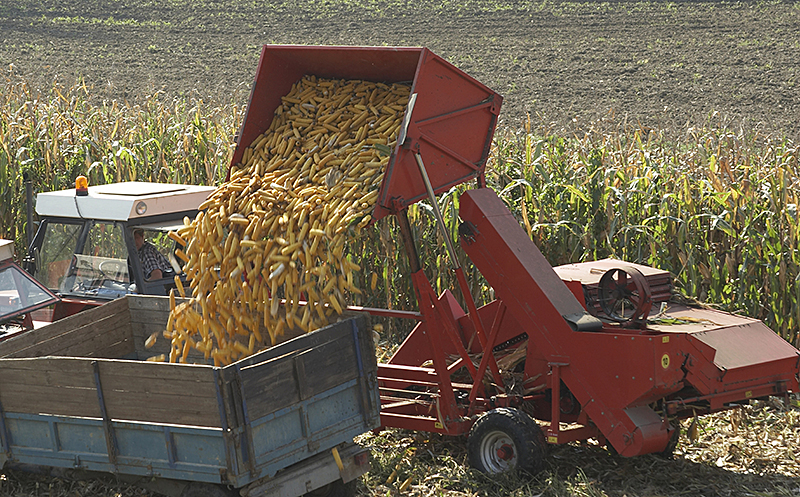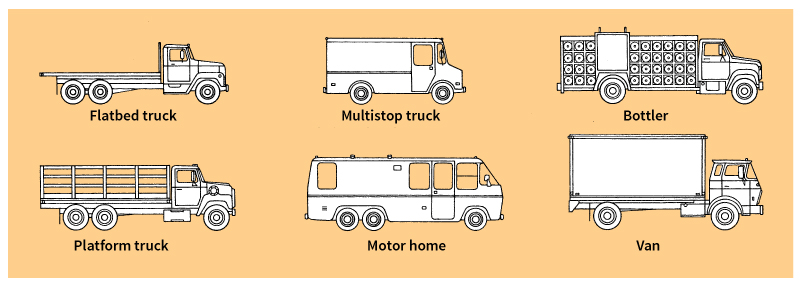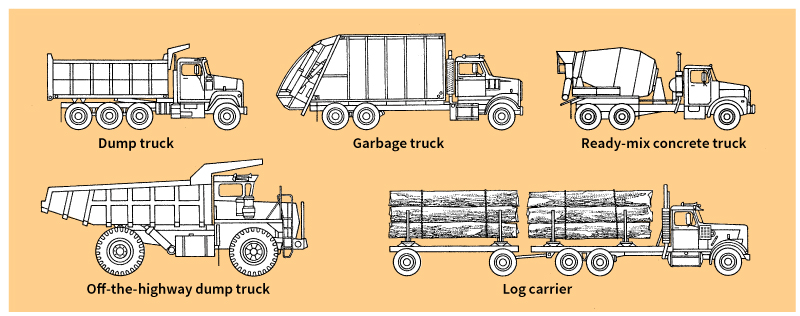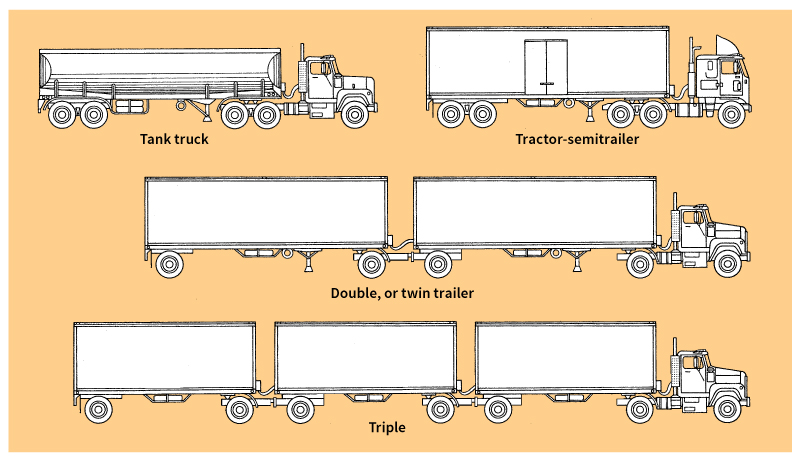Truck is a motor vehicle used to carry freight. Trucks transport a wide variety of cargo. They carry food to grocery stores and gasoline to service stations. Trucks haul manufactured products from factories to stores and, in some cases, to consumers’ homes. In fact, trucks help transport nearly everything we eat, wear, and use. Some kinds of trucks are commonly called vans. The British word for truck is lorry.
Trucking is a major industry in developed countries. In the United States, for example, trucks haul about 75 percent of the industrial products and carry most of the goods moved short distances.
Trucks vary greatly in size and style. The smallest and most common type is the pickup truck. Another very common but much larger truck is the tractor-semitrailer, often called a semi or an 18-wheeler. The tractor is the front part of the truck. It contains the cab and engine, and it pulls the semitrailer. Some tractor-semitrailers also pull a second trailer and are called doubles or twin trailers. Triples consist of a tractor pulling three trailers. 
Trucks are sturdily built to haul heavy loads. Most have engines that are more powerful than automobile engines. The engines of large trucks produce as much as 600 horsepower (375 kilowatts).
Large trucks typically have 9 to 18 forward gears and 2 or more reverse gears. The gears allow the engine to be used most efficiently so that the truck can reach and maintain desired speeds under varying conditions. Low gears make it possible for a truck to climb steep hills with a heavy load, while high gears allow it to accelerate to highway speeds. Large trucks also have strong brakes, and large tires to handle the heavy loads. Some have many axles. Axles with heavy load capacity usually have two pairs of tires.
Uses of trucks
Trucks have a wide variety of industrial, agricultural, and governmental uses. Some trucks have special uses.
Industrial uses.
Trucks serve a vital role for manufacturing industries by providing a quick and flexible means to move goods. Industries use trucks to carry raw materials to their factories and to transport manufactured products to warehouses, distribution centers, stores, or customers. In some cases, trucks carry products between factories. For example, the parts for a car may be produced at several factories and then trucked to a plant where the car is assembled. Trucks then transport the cars to automobile dealerships for sale to the public.
Utility industries use trucks extensively to maintain their systems. Trucks haul the tools and supplies needed to maintain their services and facilities. Many trucks are equipped with aerial cranes that can be raised and lowered to enable workers to maintain equipment mounted on utility poles. Many trucks have a power take-off, a mechanism that provides power for other machines, such as winches, cranes, and post-hole diggers. Similar trucks are used by tree-trimming services.
Businesses that own or lease trucks and use them to carry their own goods are known as private carriers. Trucking companies that transport freight for others are called for-hire carriers.
In the United States, there are three types of for-hire carriers: (1) common, (2) contract, and (3) exempt. Common carriers are required by law to transport the goods of any shipper who can pay for the service. Such carriers charge set rates, haul specific types of freight, and operate only on certain routes (see Common carrier ). Contract carriers work for a limited number of customers. They agree to deliver only the products of these customers. Exempt carriers transport only certain kinds of goods or use their trucks only for specific purposes. Exempt carriers include firms that haul certain agricultural products or carry newspapers. These carriers are exempt from certain government regulations.
Agricultural uses.

In agricultural areas, farmers use trucks to move cargo around farms and to and from markets. They haul fertilizer, livestock feeds, and other items needed to operate a farm. Such farm products as fruits, vegetables, and livestock are trucked from farms to markets. They thus help make it possible for supermarkets to offer a wide variety of foods. Because of the quick delivery made possible by trucks, consumers can enjoy fresh fruits and vegetables grown in distant areas.
Governmental uses.
Federal, state, regional, and municipal governments use many trucks. Postal services employ trucks to transport mail between cities and to deliver it directly to homes. The military services use trucks to carry equipment, troops, and weapons. Some military trucks are large enough to haul tanks and missile launchers. State and regional governments use trucks in the construction and maintenance of bridges, roads, and parks. Cities and municipalities use trucks for the maintenance of roads, streets, and parks and to sweep streets, clear away snow, and collect garbage. Fire departments require trucks for fire fighting and emergency services.
Special uses.
Many people use trucks to move their furniture, household goods, and personal belongings from one apartment or house to another. Trucks called bookmobiles serve as traveling libraries. Television networks send trucks outfitted with video equipment to cover news and sports events. Tow trucks haul damaged or disabled vehicles. Trucks built as ambulances have lifesaving equipment and serve as mobile emergency rooms. Motor homes are trucks outfitted with living accommodations for people who are camping or traveling (see Recreational vehicle ).
Trucks are often used in combination with other modes of transportation. For example, a loaded trailer can be separated from a truck tractor and loaded onto a railroad flatcar. The trailer is then transported to a railroad terminal near its final destination, where it is reconnected to another truck tractor and driven to the destination. Standardized shipping containers are transported by ship or train and then loaded onto tractor-semitrailers for delivery to their final destination. See Containerization .
Kinds of trucks
Truck manufacturers offer customers a choice of thousands of designs. Trucks vary in size and weight-carrying capacity. Many are outfitted with specialized equipment geared toward particular tasks. Such equipment includes cranes or ladders.
Trucks are classified as straight or combination vehicles. Straight trucks, which are also called rigid trucks or single-unit trucks, combine the cab and the cargo space on a single frame. Combination vehicles consist of a tractor and one or more trailers.
Trucks may also be classified by weight in accordance with their gross vehicle weight rating in the case of straight trucks, or gross combination weight rating in the case of combination vehicles. The ratings reflect the maximum weight of the truck and load for which the truck is designed.
Although there is no universal standard for classifying trucks by name, a light truck is generally considered to be one with a gross weight rating less than 14,001 pounds (6,364 kilograms). Medium trucks have gross weight ratings from 14,001 to 26,000 pounds (11,818 kilograms). Trucks with a gross weight rating of over 26,000 pounds are considered heavy trucks.
Most light trucks are straight trucks. Pickups are the most common and familiar light truck. A pickup has an enclosed cab and an open-topped cargo compartment. Many pickups have engines and transmissions similar to those in automobiles and can carry a load weighing about 11/2 tons (1.4 metric tons). Most light trucks have gasoline engines. But some manufacturers produce light trucks with diesel engines, which convert fuel to energy more efficiently than gasoline engines.

Medium trucks are wider and taller than light trucks. They are commonly used as commercial vehicles, such as parcel delivery trucks and beverage trucks. Parcel delivery trucks are designed so the driver can stand behind the steering wheel and easily step in and out of the cab. Beverage trucks have racks to carry bottled goods. Most medium trucks have diesel engines.

Heavy trucks perform a wide variety of rugged tasks. These vehicles include concrete mixers and dump trucks, as well as tractor-semitrailers. Concrete mixers haul a rotating drum in which concrete is mixed while the truck is in transit. The concrete is then discharged at the job site. Dump trucks have an open bed that tilts towards the rear to discharge the load. The trailer of a tractor-semitrailer is supported partially by wheels and partially by the powerful tractor that pulls it. The trailer connects to the tractor through a coupling known as a fifth wheel. This coupling enables a trailer to be removed from a tractor and another to be connected. Almost all heavy trucks have diesel engines. The engines are designed to be very durable since they must operate at high power levels for long periods of time.


Another way of grouping trucks is according to where they are used. Trucks may be classified as on-highway or off-highway trucks.
On-highway trucks
are used on roads. The most common types of on-highway trucks include pickups, tractor-semitrailers, and panels. A panel is a small, fully enclosed truck. Other kinds of on-highway trucks include flatbed trucks and tank trucks. Flatbed trucks have an enclosed cab in front of a flat, open platform for loading cargo. The platform may have brackets along its perimeter so that stakes can be inserted to help restrain the load. Flatbed trucks are also called platform or stake trucks. They are used to haul large pieces of equipment and other bulky cargo. Tank trucks are outfitted with a large tank for carrying liquids, such as gasoline or milk, or compressed gas. Some are straight trucks, and some are tractor-semitrailers.
Light vans are commonly used for delivering goods locally to stores and homes. Heavier vans transport furniture or bulky goods. Refrigerated vans called reefers are used to carry perishable food and other products that require cooling.
Off-highway trucks
are designed and built for use on rugged terrain rather than on highways. They are used on construction sites and in lumber camps, mines, oil fields, and quarries. These trucks are much larger and can haul much heavier loads than what are allowed on highways. The largest off-highway trucks used in North America measure 471/2 feet (14.5 meters) long and 30 feet (9.1 meters) wide. These huge trucks are used at mining sites and can transport loads weighing 380 tons (345 metric tons). Some off-highway trucks are equipped with machinery used for earth-moving, hoisting, or pumping. Small electric-powered trucks that carry loads inside factories are also a kind of off-the-highway truck.
Common features of trucks
Truck cabs come in two styles—conventional and cab-over-engine (COE). Conventionals are identifiable by a cab set behind the hood covering the engine. COE’s have the engine placed under the cab with no visible hood protruding in front of the windshield. The cabs of some tractor-semitrailers are equipped with a bed in which drivers can sleep when they stop during long trips. These cabs are called sleeper cabs.
Heavy trucks have large brakes at each wheel. Some also have brakes incorporated into the engine or into the driveline, which connects the transmission to the driving axle. These brakes, called retarders, reduce wear on the wheel brakes by absorbing energy to slow the truck. Many trucks have anti-lock brake systems that prevent the wheels from locking during braking so they stop more safely on slippery surfaces.
Trucks have one front axle used for steering. On some trucks this axle may also function as a driving axle. Some special-use trucks have a second axle at the front of the truck that is also used for steering.
Trucks have various types of suspension systems that use rubber, steel springs, or air springs (devices that use compressed air to absorb shock and vibration). The suspension system isolates the truck body from the axles to reduce shocks from bumps in the road. Many trucks have two rear axles known as tandem axles. Tandems share a common suspension system to help equalize the loads on the axles. Tandem axle suspensions with leaf springs (springs made of layers of curved metal strips) are known as four-spring suspensions. Some include beams between the axles known as walking beams.
Regulation of trucks
In most countries, the operation of trucks is strictly controlled by laws. Among other things, these laws define the allowable physical size of the truck in terms of width, height, and length, and the maximum weight permitted. In order to use highways, trucking companies must pay taxes on each truck they operate in accordance with the size of the truck.
Truck drivers must take special tests to obtain a license to drive a truck on public highways. Government regulations limit the number of hours each day a driver may operate a truck and require the driver to maintain a daily log of driving time. In some countries, trucks are equipped with devices that automatically record daily driving activities. Some trucks are also equipped with navigation systems that use a network of satellites called the Global Positioning System to provide continuous information about their location.
Most countries apply very strict safety standards to trucks. Some require annual testing of such critical features as brakes, tires, and steering. Special rules govern the transport of chemicals and other hazardous materials.
History
Nicolas-Joseph Cugnot, a French military engineer, built the first self-powered road vehicles in 1769 and 1770. One was a steam-powered, three-wheel vehicle designed to tow artillery pieces. This vehicle might well be considered the first truck.
By the early 1900’s, manufacturers in many countries were building trucks. They had solid rubber tires and crude spring suspension systems, which made traveling over the bumpy roads of the time uncomfortable for the driver and rough on the cargo. Nevertheless, the early trucks were more efficient and less costly than the horse-drawn vehicles they replaced. However, the railroads carried most of the long-distance freight.
Improvements in truck design and development of air-filled, pneumatic tires soon enabled trucks to carry heavier loads at greater speeds. The motorized trucking industry grew rapidly. Trucks proved especially valuable during World War I (1914-1918) by carrying supplies to soldiers at the front lines.
During the 1920’s, in the United States, the federal and state governments began building a national system of highways. The improved roads enabled trucks to travel between cities more quickly. Trucks were used extensively during World War II (1939-1945). After the war, many countries began to improve their road systems. In the United States, a network of high-speed interstate highways was built, allowing bigger and faster trucks to compete effectively with trains as freight carriers.
Careers
The trucking industry employs millions of people around the world. It employs many kinds of workers besides drivers. Dispatchers direct trucks to the proper destination with the correct cargo. Freight handlers and loading-dock and warehouse workers load and unload trucks. Mechanics repair and maintain trucks. Trucking firms employ such office workers as shipping clerks and computer programmers. Truck manufacturers employ engineers and factory workers. Companies that produce engines, tires, and other parts for trucks also offer employment opportunities.
